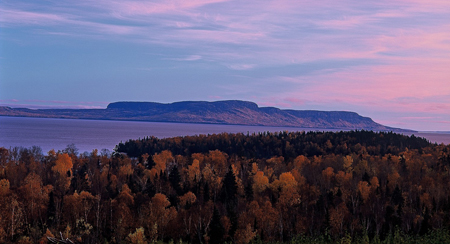
North Shore of Lake Ontario
Credit: Garth Lenz
While still largely undervalued as an important part of slowing climate change, forests are starting to get some of the international attention they've been owed for years. There have been increasing numbers of stories in the media and online about how important protecting forests are for our climate, and this op-ed in the New York Times hits the nail on the head as leaders set up camp in the Copenhagen climate summit this week (click here to view original source):
Thousands of experts and politicians are gathering in Copenhagen to search for ways to sharply reduce the amount of carbon we release into the atmosphere. Whatever limit they agree to — whether it is 350 or 400 parts per million — will require, first and foremost, curtailing global emissions. It will also require ways to absorb carbon, or carbon sinks.
Multibillion-dollar technological approaches to storing carbon, from pumping it into depleted oil wells to building massive carbon absorption systems, are grabbing people's imagination. At the same time — and inexplicably — a more convenient and less expensive method is being overlooked.
The Intergovernmental Panel on Climate Change has determined that 20 percent of greenhouse gas emissions come from deforestation and other forms of land use change. Live vegetation absorbs CO2 and releases oxygen. This function is eliminated when forests are cut.
More importantly, forests can hold 20 to 100 times more carbon dioxide than agricultural systems could on the same amount of land.
When coastal marshes are drained, soils ploughed or peat lands burned, the carbon stored there is exposed to oxygen with which it forms CO2 and finds its way into the atmosphere. There it persists for a long time, trapping heat as a greenhouse gas.
Adding insult to injury, these land-use conversions also destroy natural carbon sinks. For example, most carbon accumulated in coastal marshlands does not find its way into the atmosphere. A recent calculation shows that had the Bay of Fundy marshlands in Canada not been converted to farmland, they would be absorbing the equivalent to 4 to 6 per cent of Canada's CO2 reduction target.
Put simply, if we stop converting intact ecosystems, we would not only arrest 20 percent of greenhouse gas emissions, but we'd continue to have natural carbon sinks — all without investing in technological fixes.
Halting forest degradation and forest restoration are on the agenda in Copenhagen. But not protecting intact ecosystems, which is by far the least expensive of all the solutions to be discussed in Copenhagen.
Arguments in favor of a "natural solution" do not stop with curbing further carbon emissions and protecting carbon sinks. Intact ecosystems also yield benefits for people and other species. They provide clean water, clean air, pollinators and food, especially sea food. These are beneficial for physical and mental health.
Intact ecosystems also serve as insurance against floods, landslides and even tsunamis. The actual and replacement worth of such services would be in the billions of dollars.
National parks and other forms of protected areas around the world have a particular role in a "natural solution." They are arguably the most effective management strategy known to avoid conversion to other land uses.
Nearly 14 percent of the world's land surface, containing more than 15 percent of the world's terrestrial carbon stock, is already under protection, along with significant areas of the sea. In many parts of the world, protected areas contain the remaining vestiges of intact ecosystems.
In Madagascar, 6 million hectares of new protected areas are responsible for 4 million tons of CO2 that does escape into the atmosphere per year. Canada's national parks have an estimated 4.4 billion tons of carbon stored mostly in peatlands and soils, while Brazil's Amazon system of protected areas prevents 8 billion tons of carbon from being released.
One third of the world's 100 major cities, totaling 1 billion people, get their water supplies from a protected area.
The combination of storing unreleased carbon and protecting ecosystems should make protected areas a natural component of any strategy discussed in Copenhagen.
The conference should recognize the role of protected areas as tools for permanent carbon storage and call on countries to implement robust protected-area systems as a core component of national strategies to achieve land and marine-based emissions reductions.
Nikita Lopoukhine is chairman of the IUCN World Commission on Protected Areas and a co-author of "Natural Solutions: Protected Areas Helping People Cope with Climate Change."

